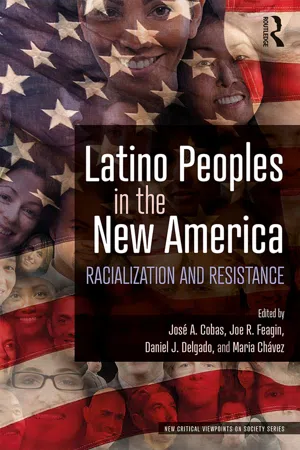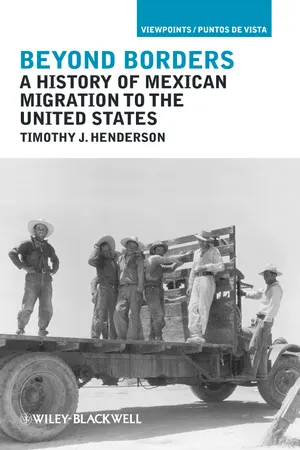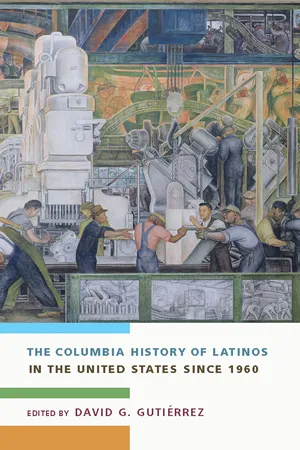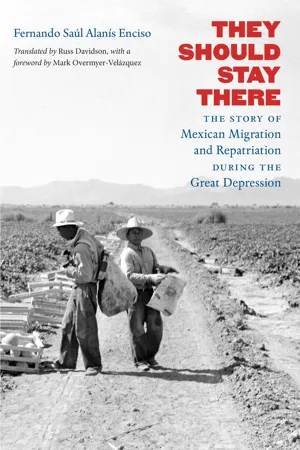History
Mexican Repatriation
The Mexican Repatriation was a mass deportation of Mexican immigrants and Mexican Americans from the United States during the 1930s. This was a result of economic depression and anti-immigrant sentiment, leading to the forced removal of hundreds of thousands of individuals, many of whom were U.S. citizens. The repatriation had a significant impact on Mexican American communities and families.
Written by Perlego with AI-assistance
Related key terms
6 Key excerpts on "Mexican Repatriation"
- eBook - ePub
Latino Peoples in the New America
Racialization and Resistance
- José A. Cobas, Joe R. Feagin, Daniel J. Delgado, Maria Chávez(Authors)
- 2018(Publication Date)
- Routledge(Publisher)
The rising numbers of Mexicans in the first three decades of the twentieth century resulted in many whites seeking to halt this growth. The Great Depression in 1929 represented a catalyst for deporting Mexicans conveniently treated as a scapegoats. Mexicans were seen as a public charge and as competitors for scarce jobs and resources. President Hoover authorized the Mexican Repatriation Program in 1929, with President Franklin D. Roosevelt extending it until 1939. Balderrama and Rodríguez (2006) describe the context in which the repatriation of Mexicans was carried out:In a frenzy of anti-Mexican hysteria, wholesale punitive measures were proposed and undertaken by government officials at the federal, state, and local levels. Immigration and deportation laws were enacted to restrict emigration and hasten the departure of those already here. Contributing to the brutalizing experience were the mass deportation roundups and repatriation drives. Violence and “scare-head” tactics were utilized to get rid of the burdensome and unwanted horde. An incessant cry of “get rid of the Mexicans” swept the country.(ibid.: 1)Estimates of the number of Mexicans who were deported or voluntarily returned to Mexico vary widely from 400,000 to 2 million, numbers that included persons who were US citizens (Sáenz and Murga 2011). The most common estimate is approximately 500,000, which represents about one-third of persons of Mexican origin enumerated in the US census in 1930 (ibid.). The repatriation program proved to be the most effective tactic for reducing the presence of Mexicans in the United States.The eugenics movement beginning in the late nineteenth century set the context for this action. Recall that Americans vigorously used eugenics arguments to bring to a close immigration from Southern and Eastern Europe. Similarly, many Americans wanted to halt the growth of the Mexican population because they were seen as genetically and morally inferior to whites as well as people who brought contagious diseases to this country. Molina (2010) draws on archival records to show how a group of Mexican workers living in California’s Imperial Valley, some of whom were union organizers, were targeted in 1940 for deportation due to treatment that they received for a sexually communicable disease. The men had immigrated legally to the United States and had worked regularly without any problems. Immigration officials linked their medical treatment for curing syphilis to them being “likely to become a public charge (LPC),” which rendered them deportable. The men were arrested and deported. The tropes of disease and public charge sealed their fate. - eBook - ePub
Three Worlds of Relief
Race, Immigration, and the American Welfare State from the Progressive Era to the New Deal
- Cybelle Fox(Author)
- 2012(Publication Date)
- Princeton University Press(Publisher)
CHAPTER 7
Repatriating the Unassimilable Aliens
Writing in theAMERICAN MERCURYin the early 1930s, Carey McWilliams pointedly described the origins of the great exodus of Mexicans and Mexican Americans streaming south across the Rio Grande.When it became apparent last year that the program for the relief of the unemployed would assume huge proportions in the Mexican quarter, the community swung to a determination to oust the Mexican. . . . At this juncture, an ingenious social worker suggested the desirability of a wholesale deportation. But when the federal authorities were consulted, they could promise but slight assistance, since many of the younger Mexicans . . . were American citizens. . . . Moreover, the federal officials insisted on, in cases of illegal entry, a public hearing and a formal order of deportation. This procedure involved delay and expense, and, moreover, it could not be used to advantage in ousting any large number. A better scheme was soon devised.1That “better scheme” was repatriation: the voluntary removal of aliens to their native country. Aliens can repatriate themselves or they may receive assistance in doing so from friends, relatives, local public or private agencies, the federal government, or their local consulate. It is distinct from deportation, which can only be carried out by the federal Immigration Service and does not require the alien’s consent.While welfare scholars have ignored the role that welfare agencies have played in the expulsion of individuals from the country, historians and Chicano studies scholars have produced rich and compelling accounts of the mass repatriation of Mexicans during the Great Depression.2 - eBook - ePub
Beyond Borders
A History of Mexican Migration to the United States
- Timothy J. Henderson(Author)
- 2011(Publication Date)
- Wiley-Blackwell(Publisher)
Alongside the scare campaign of 1931 was another, unrelated effort carried out in cities across the United States to repatriate Mexicans. These campaigns were undertaken by city and county welfare bureaus and private charities that were principally concerned with the burden of unemployed Mexicans on relief. Los Angeles welfare officials estimated that unemployed Mexicans were costing the city at least $200,000 per month; compared to that, the cost of deporting them was a relative bargain. Mexicans with little hope of finding employment were amenable enough to the offer of repatriation, for if nothing else it would give them an all-expense paid trip to visit family in Mexico. Repatriates were offered free transportation to El Paso or Nogales, plus food, clothing, and medical care. The Mexican government did its part by offering free rail transport from the border to the interior, charging repatriates no duties on cars, trucks, tools, appliances, and whatever else they might bring with them from the United States. Among the repatriates were a considerable number of US citizens, particularly the children of immigrants who had been born and raised in the United States and who had much difficulty adjusting to life in Mexico. By the mid-1930s the pace of repatriation had declined considerably, mostly owing to Franklin Roosevelt’s policies of providing federal funds to local welfare programs and sponsoring massive public works projects, both of which eased the burden on local relief agencies. There is no reliable figure on the total number of Mexicans repatriated during the 1930s, though most estimates hover around 150,000.The Fate of the RepatriatesRepatriated Mexicans returned to Mexico to find ongoing hardship in their home country, and they in turn added to the already existing surplus of labor. The natural increase in Mexico’s population was more than 50 percent during the 1930s, and repatriates swelled that population increase by another 10 percent. In the north-central region of the country – the source of the majority of immigrants to the United States – corn prices doubled as agricultural production fell to pre-revolutionary levels and Mexico was forced to import large quantities of corn and wheat. Returning migrants also faced the fact that no one could agree quite what to make of them. Repatriates came home to a certain amount of suspicion that, having tasted the good life, they might now find Mexico sadly wanting, and might therefore threaten the nation’s political stability. Some saw Mexicans who had left as traitors who had abandoned their homeland, and who now came back – some of them, anyway – flaunting their newfound worldliness. This was a popular theme in Mexican corridos (folk songs) of the era. For example, in a corrido called “The Renegade,” the singer excoriates repatriates thus: “… they learn a little American / And dress up like dudes / And go to the dance / But he who denies his race / Is the most miserable creature / There is nothing in the world so vile as he / The mean figure of the renegade.”10 - eBook - ePub
Migrating Faith
Pentecostalism in the United States and Mexico in the Twentieth Century
- Daniel Ramírez(Author)
- 2015(Publication Date)
- The University of North Carolina Press(Publisher)
2Trouble in the Borderlands: The Great Repatriation
The history of the massive repatriation of Mexicans from the United States during the decade of the 1930s is not well known among American religious historians. Mexicans had already served as convenient and deportable targets of the previous decade’s “Red Scare”“ but subsequently had filled—at numbers reaching to 500,000 in the 1920s by one estimate—the labor vacuum caused by the 1917 and 1924 Immigration Acts.3 The country’s renewed economic vicissitudes prompted a new hunt for ready scapegoats. Federal, state, county, and local authorities, as well as civic elites, joined efforts to expel “unwanted” Mexicans. Several dramatic and well-publicized raids—with accompanying newspaper photos of deportee trainloads—provided the impetus for a large-scale “voluntary” exodus. According to Abraham Hoffman, the number repatriated totaled 458,039, including many children born in the United States.4 Francisco Balderrama and Raymond Rodríguez, citing official and journalistic sources, calculated a much higher, albeit, according to them, still conservative number of one million.5 Hoffman’s lower estimate represents, nevertheless, a considerable demographic loss of about 35 percent, since the census of 1930 counted 1.3 million Mexicans in the United States. In other words, the massive exodus uprooted one out of every three Mexicans.6 It also uprooted one out of three Pentecostals. The dimensions of the calamity were even greater in the smaller and more tenuous midwestern Mexican communities of Detroit, Chicago, and Gary, Indiana. Since blood ties spanned legal categories, entire families (including scores of thousands of U.S.-born children) were effectively leveraged out of the United States. U.S. agencies underwrote rail transportation and secured Mexican government waivers of duty tariffs for household items and automobiles; thus, the majority of repatriados - David Gutiérrez(Author)
- 2004(Publication Date)
- Columbia University Press(Publisher)
brazos).The Bracero Program was originally designed to meet the increased wartime demand for agricultural and railroad workers, but after the war the program was extended several times in different versions. Over the next quarter-century, this “temporary” foreign labor importation program was responsible for recruiting more than 5 million workers to the United States. The terms of the various labor agreements prohibited contract workers from settling permanently in the United States unless they first returned to Mexico and went through ordinary immigration application procedures, but the constant circulation of this volume of workers inevitably led to a steady increase of the number of Mexicans who settled in the United States. The Bracero Program also stimulated a dramatic parallel increase in the circulation of similar numbers of undocumented workers who were drawn into the U.S. labor market outside of the official labor-recruitment channels. As braceros became familiar with life in the United States, they encouraged friends and relatives to try their luck in the north, again, often outside of the formal labor-recruitment mechanisms. Of course, U.S. employers who sought to avoid both the red tape and the contract guarantees of the program welcomed the renewed flow of unsanctioned Mexican workers. Thus, after the war, a number of interlocking factors contributed to a continuing increase in the ethnic Mexican population. The volatile combination of the constant circulation of a large number of temporary, legally sanctioned workers, a similar transnational circulation of even larger numbers of unsanctioned, “illegal” laborers, and the smaller, but still significant entry of thousands of Mexican immigrants through regular immigration channels all led to the steady growth of the ethnic Mexican population. Combined with a high birth rate in the resident population, these factors contributed to a population increase of at least 73 percent between 1940 and 1950, and another 54 percent increase between 1950 and 1960.5 By 1960, the ethnic Mexican population of the United States had reached approximately 3.5 million.6- eBook - ePub
They Should Stay There
The Story of Mexican Migration and Repatriation during the Great Depression
- Fernando Saúl Alanís Enciso, Russ Davidson(Authors)
- 2017(Publication Date)
- The University of North Carolina Press(Publisher)
Although the executive branch was forced to devote most of its attention to negotiating and steering through a confrontational political climate, it nonetheless made time to inform itself about the situation of the Mexican community in the United States. The subject was not new to Cárdenas; he was already aware of the difficulties faced by his compatriots who had migrated in search of work. He had acquired that understanding during the four-year period, 1928–32, when he served intermittently as governor of Michoacán—one of the states, along with Jalisco and Guanajuato, with the highest levels of migration—and also during the unrest that still afflicted the country during the 1920s, when the number of Mexicans leaving for the United States increased notably. In addition, the mass return of his compatriots that occurred in the early 1930s, and the problems they confronted once they had arrived back in Mexico, did not escape his notice. Indeed, during his campaign for the presidency in 1933, Cárdenas called attention to the case of the repatriated who had settled in Pinotepa, Oaxaca, and to whom he extended help (Hoffman 1974, 141).The expectation that the border between Mexico and the United States would continue to see migrants, in considerable numbers, flowing back and forth across it was never far from his mind. At the same time, however, it was well known that the return of Mexican nationals stoked fear within official circles and that concern was growing over what actions the government should take if a mass repatriation occurred and what preparations it should make. For the time being, the government did nothing either in the legislative arena or in the wider public administration context to focus on or promote the return of its compatriots. It confined itself to giving support in urgent cases only and to studying and analyzing conditions in Baja California with the objective of using that state as a place to locate and settle Mexican nationals coming back from the United States.The Threat of Expulsions and the Ensuing Reaction
At the end of 1934, as Cárdenas was being inducted into office, the Mexican government faced the threat of a massive return movement when public assistance officials in Los Angeles County appeared to be on the verge of deporting between 15,000 and 25,000 families of Mexican origin. Francisco J. Múgica, the incoming administration’s minister of industry and commerce, believed that the country might have to welcome back at least 50,000 people, a development he believed would pose a “truly urgent, complex” problem of “transcendent importance.” It could only be addressed if the government devised a plan to confront it, one that detailed just how these thousands of individuals would be accommodated.2
Learn about this page
Index pages curate the most relevant extracts from our library of academic textbooks. They’ve been created using an in-house natural language model (NLM), each adding context and meaning to key research topics.





